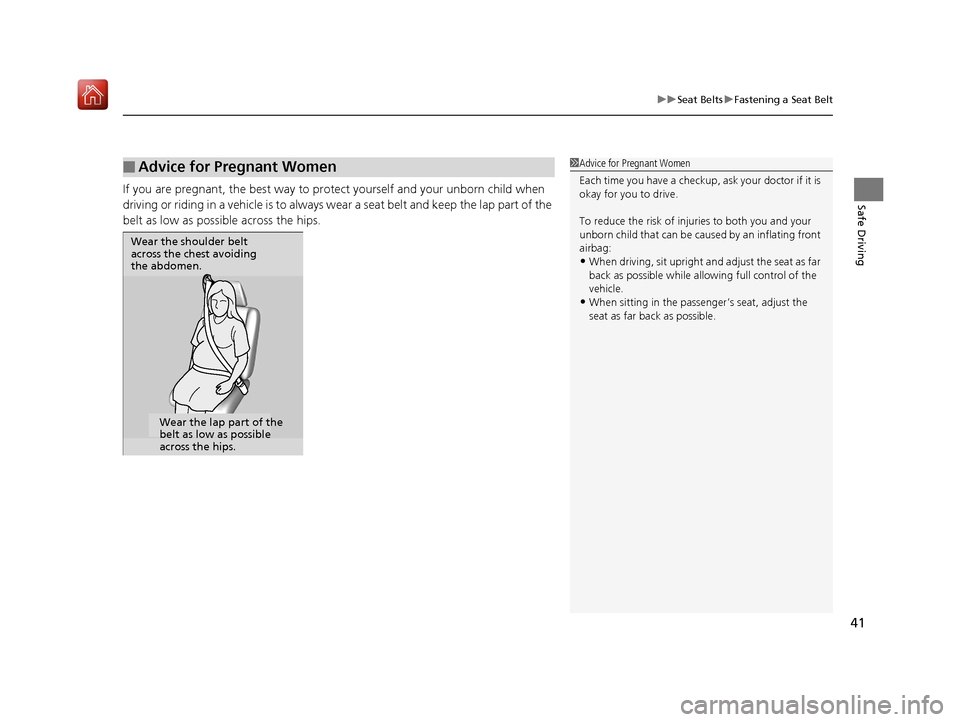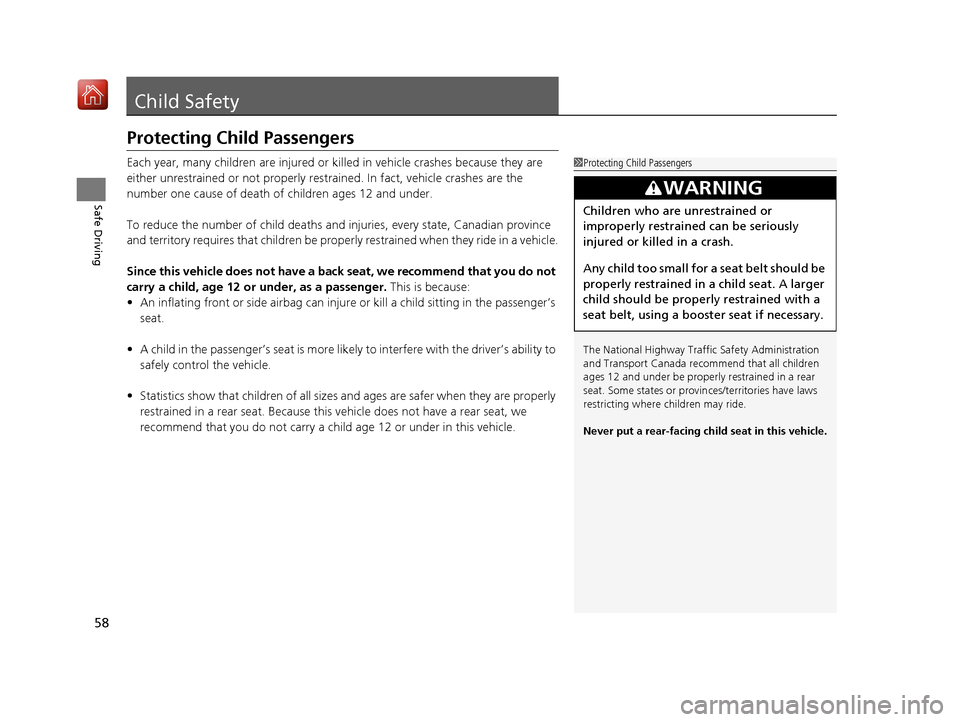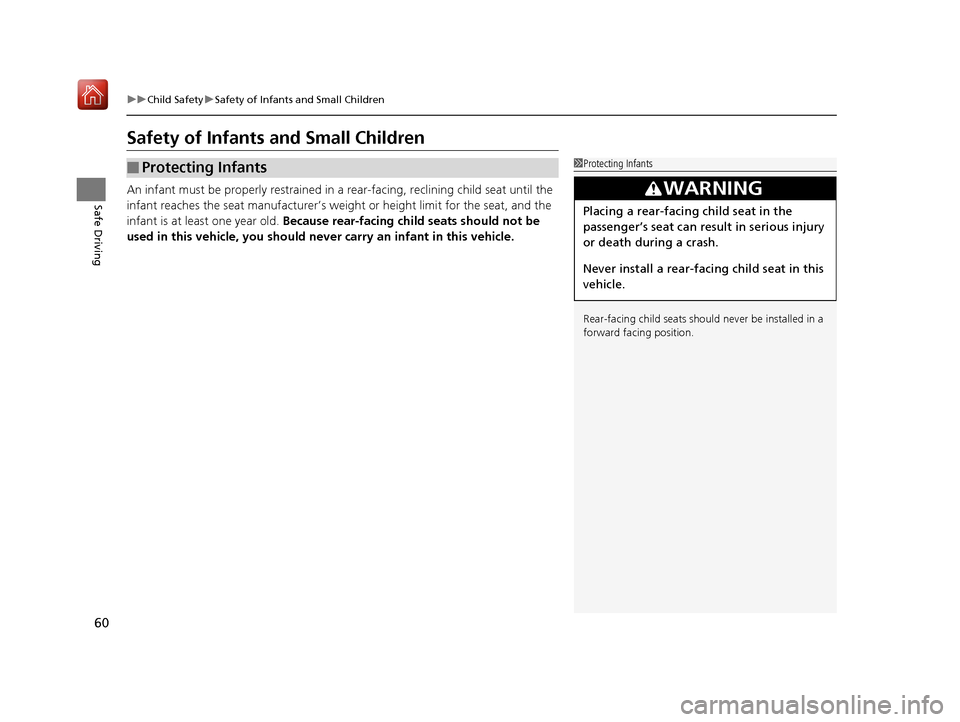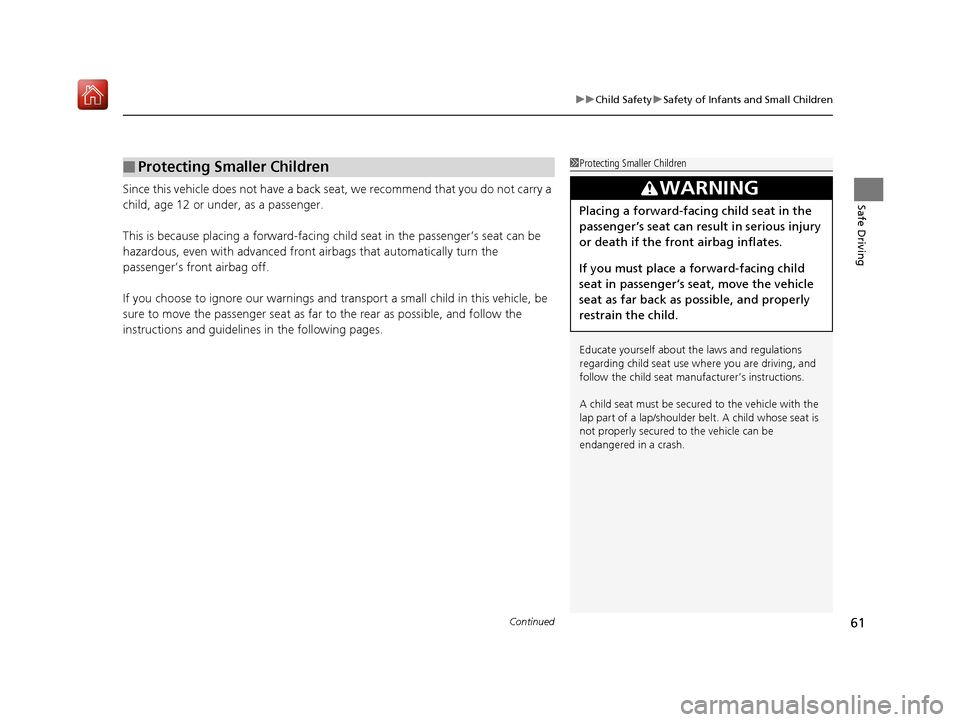2018 Acura NSX child seat
[x] Cancel search: child seatPage 42 of 489

41
uuSeat Belts uFastening a Seat Belt
Safe DrivingIf you are pregnant, the best way to prot ect yourself and your unborn child when
driving or riding in a vehicle is to always wear a seat belt and keep the lap part of the
belt as low as possible across the hips.
■Advice for Pregnant Women1 Advice for Pregnant Women
Each time you have a checkup, ask your doctor if it is
okay for you to drive.
To reduce the risk of inju ries to both you and your
unborn child that can be caus ed by an inflating front
airbag:
•When driving, sit upright a nd adjust the seat as far
back as possible while allowing full control of the
vehicle.
•When sitting in the passenger’s seat, adjust the
seat as far back as possible.
Wear the shoulder belt
across the chest avoiding
the abdomen.
Wear the lap part of the
belt as low as possible
across the hips.
18 NSX-31T6N6100.book 41 ページ 2017年10月27日 金曜日 午後1時39分
Page 45 of 489

44
uuAirbags uAirbag System Components
Safe Driving
The front, driver’s knee, side, and side
curtain airbags are deployed according to
the direction and severity of impact. Both
side curtain airbags are deployed in a
rollover. The airbag system includes:
aTwo SRS (Supplemental Restraint System)
front airbags. The driver’s airbag is stored
in the center of the steering wheel; the
passenger’s airbag is stored in the
dashboard. Both are marked SRS
AIRBAG.
bDriver’s knee airbag. The knee airbag is
stored under the steering column. It is
marked SRS AIRBAG.
cTwo side airbags, one for the driver and
one for a passenger. The airbags are
stored in the outer edges of the seat-
backs. Both are marked SIDE AIRBAG .
dTwo side curtain airbags, one for each
side of the vehicle. The airbags are stored
in the ceiling, above the side windows.
The front and rear pillars are marked
SIDE CURTAIN AIRBAG.
eAn electronic control unit that, when the
power system is on, continually monitors
information about the various impact
sensors, seat and buckle sensors, rollover
sensor, airbag activators, seat belt
tensioners, and other vehicle
information. During a crash event the
unit can record such information.
fAutomatic seat belt tensioners. In
addition, the driver’s and passenger’s
seat belt buckles incorporate sensors that
detect whether or not the belts are
fastened.
gWeight sensors in the passenger’s seat.
The passenger’s airbag will be turned off
if the weight on the seat is 65 lbs (29 kg)
or less (the weight of an infant or small
child).
hImpact sensors that can detect a
moderate-to-severe front or side impact.
iAn indicator on the dashboard that alerts
you that the passenger’s front airbag has
been turned off.
jAn indicator on the instrument panel that
alerts you to a possible problem with your
airbag system or seat belt tensioners.
kA rollover sensor that can detect if your
vehicle is about to roll over and signal the
control unit to deploy both side curtain
airbag.
18 NSX-31T6N6100.book 44 ページ 2017年10月27日 金曜日 午後1時39分
Page 50 of 489

49
uuAirbags uFront Airbags (SRS)
Safe DrivingThe passenger’s airbag have advanced f eatures to help reduce the likelihood of
airbag related injuries to a smaller occupant. The passenger’s advanced airbag system has
weight sensors.
We advise against allowi ng a child age 12 or
under to ride in the passenger’s seat.
However, if you do allow a child age 12 or
under to ride in the passenger’s seat, note
that the system will auto matically turn off the
passenger’s airbag if the sensors detect that
the child is approximately 65 lbs (29 kg) or
less.
■Advanced Airbags1 Advanced Airbags
For the passenger’s advanced front airbag to work
properly:
•Do not spill any liquid on or under the seat.
•Do not put any object under the passenger’s seat.•Make sure any objects are positioned properly on
the floor. Improperly pos itioned objects can
interfere with the advanced airbag sensors.
•An occupant should sit uprig ht and wear their seat
belts properly.
•Do not place any cover over the passenger side
dashboard. 2 Passenger Airbag Off Indicator P. 56
Passenger’s
Seat
Weight
Sensors
18 NSX-31T6N6100.book 49 ページ 2017年10月27日 金曜日 午後1時39分
Page 57 of 489

uuAirbags uAirbag System Indicators
56
Safe Driving■When the passen ger airbag off
indicator comes on
The indicator comes on to alert you that the
passenger’s front airbag has been turned off.
This occurs when the weight sensors detect
about 65 lbs (29 kg) or less, the weight of an
infant or small child, on the seat.
Your vehicle is not recommended for child passengers. Never put a rear-facing child
seat in this vehicle.
If you decided to disregard our recommendations and transport a small child, they
should be properly restrained.
2 Child Safety P. 58
Objects placed on the seat can also cause the indicator to come on.
If the passenger seat is empty, the passeng er’s front airbag will not deploy and the
indicator will not come on.
■Passenger Airbag Off Indicator1 Passenger Airbag Off Indicator
To ensure the passenger is detected properly,
confirm that:
•There is no object pressing against the rear of the
seat-back.
•The passenger’s seat or seat-back is not forced
back against the rear wall of the vehicle.
•There is no object placed under or beside the
passenger’s seat.
•The occupant is sitting in an upright position and
the seat back is not excessively reclined.
•The occupant is not leaning against the door or
center console.
•The occupant’s feet are plac ed on the floor in front
of them.
•There are no objects hanging from the passenger’s
seat.
The passenger airbag off indicator may come on and
go off periodically if the tota l weight on the seat is
near the airbag cutoff threshold.
Have your vehicle checked by an authorized Acura
NSX dealer as soon as possible if:
•All of the above conditions are met, and the
indicator comes on with an adult riding there.
•All of the above conditions are met, and the
indicator goes off with a small child riding there.
(See Child Safety.)
•If the seat is empty and the indicator is on.
Do not allow an adult passe nger to ride in the seat
when the indicator is on.
U.S. Canada
18 NSX-31T6N6100.book 56 ページ 2017年10月27日 金曜日 午後1時39分
Page 59 of 489

58
Safe Driving
Child Safety
Protecting Child Passengers
Each year, many children are injured or killed in vehicle crashes because they are
either unrestrained or not properly res trained. In fact, vehicle crashes are the
number one cause of death of children ages 12 and under.
To reduce the number of child deaths and in juries, every state, Canadian province
and territory requires that children be prope rly restrained when they ride in a vehicle.
Since this vehicle does not have a back seat, we recommend that you do not
carry a child, age 12 or under, as a passenger. This is because:
• An inflating front or side ai rbag can injure or kill a child sitting in the passenger’s
seat.
• A child in the passenger’s seat is more likel y to interfere with the driver’s ability to
safely control the vehicle.
• Statistics show that children of all sizes and ages are safer when they are properly
restrained in a rear seat. Because this vehicle does not have a rear seat, we
recommend that you do not carry a child age 12 or under in this vehicle.1 Protecting Child Passengers
The National Highway Traffic Safety Administration
and Transport Canada recommend that all children
ages 12 and under be properl y restrained in a rear
seat. Some states or provin ces/territories have laws
restricting where ch ildren may ride.
Never put a rear-facing child seat in this vehicle.
3WARNING
Children who are unrestrained or
improperly restrained can be seriously
injured or killed in a crash.
Any child too small for a seat belt should be
properly restrained in a child seat. A larger
child should be properly restrained with a
seat belt, using a booster seat if necessary.
18 NSX-31T6N6100.book 58 ページ 2017年10月27日 金曜日 午後1時39分
Page 60 of 489

59
uuChild Safety uProtecting Child Passengers
Safe Driving
• Any child who is too small to wear a seat belt correctly must be restrained in an
approved child seat that is properly secured to the vehicle using the lap belt
portion of the lap/shoulder belt.
• Never hold a child on your lap because it is impossible to protect them in the
event of a collision.
• Never put a seat belt over yourself and a child. During a crash, the belt would
likely press deep into the child and cause serious or fatal injuries.
• Never let two children use the same seat belt. Both children could be very
seriously injured in a crash.
• Do not allow children to operate the doors, windows or seat adjustments.
• Do not leave children in the vehicle unatte nded, especially in hot weather when
the inside of the vehicle can get hot enough to kill them. They could also activate
vehicle controls causing it to move unexpectedly.1 Protecting Child Passengers
To deactivate a lockable retractor, release the buckle
and allow the seat belt to wind up all the way.
To remind you of the pa ssenger’s front airbag
hazards and child safety, your vehicle has warning
labels on the dashboard (U.S. models) and on the
front visors. Please read and follow the instructions
on these labels. 2 Safety Labels P. 68
3WARNING
Allowing a child to play with a seat belt or
wrap one around their neck can result in
serious injury or death.
Instruct children not to play with any seat
belt.
18 NSX-31T6N6100.book 59 ページ 2017年10月27日 金曜日 午後1時39分
Page 61 of 489

60
uuChild Safety uSafety of Infants and Small Children
Safe Driving
Safety of Infants and Small Children
An infant must be properly restrained in a rear-facing, reclining child seat until the
infant reaches the seat manufacturer’s weig ht or height limit for the seat, and the
infant is at least one year old. Because rear-facing child seats should not be
used in this vehicle, you should neve r carry an infant in this vehicle.
■Protecting Infants1Protecting Infants
Rear-facing child seats should never be installed in a
forward facing position.
3WARNING
Placing a rear-facing child seat in the
passenger’s seat can result in serious injury
or death during a crash.
Never install a rear-facin g child seat in this
vehicle.
18 NSX-31T6N6100.book 60 ページ 2017年10月27日 金曜日 午後1時39分
Page 62 of 489

Continued61
uuChild Safety uSafety of Infants and Small Children
Safe DrivingSince this vehicle does not have a back seat, we recommend that you do not carry a
child, age 12 or under, as a passenger.
This is because placing a fo rward-facing child seat in the passenger’s seat can be
hazardous, even with advanced front airbags that automatically turn the
passenger’s front airbag off.
If you choose to ignore our warnings and transport a small child in this vehicle, be
sure to move the passenger seat as far to the rear as possi ble, and follow the
instructions and guidelines in the following pages.
■Protecting Smaller Children1 Protecting Smaller Children
Educate yourself about th e laws and regulations
regarding child seat use wh ere you are driving, and
follow the child seat manufacturer’s instructions.
A child seat must be secure d to the vehicle with the
lap part of a lap/shoulder be lt. A child whose seat is
not properly secured to the vehicle can be
endangered in a crash.
3WARNING
Placing a forward-facing child seat in the
passenger’s seat can result in serious injury
or death if the front airbag inflates.
If you must place a forward-facing child
seat in passenger’s seat, move the vehicle
seat as far back as possible, and properly
restrain the child.
18 NSX-31T6N6100.book 61 ページ 2017年10月27日 金曜日 午後1時39分